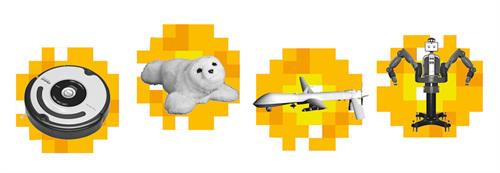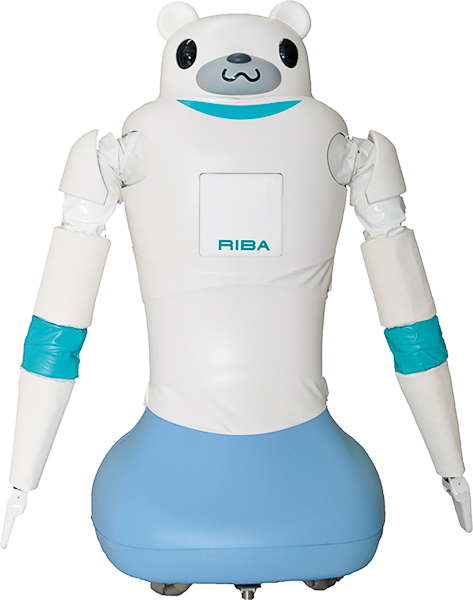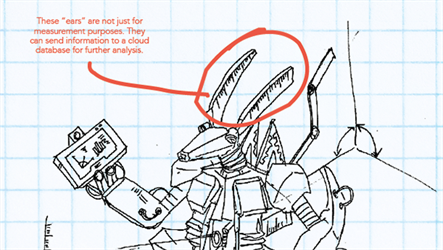Living and Working alongside Robot Buddies

At the Villa Francis Home for the Aged in Yishun, a furry visitor has captured the hearts of residents. Often seen cuddled in the arms of one of the seniors, the stuffed monkey laughs when it is caressed and whines when it is hit. A video made by the Home shows another resident hugging it tightly and patting its head, even giving it a kiss.
Clearly this is no ordinary soft toy. Meet the HuGGler, a robot that reacts to human touch as a pet would. Created by the Agency for Science, Technology and Research (A*STAR) for the elderly, the HuGGler has helped to improve their emotional and mental well-being, to “become more open, and [by] facilitat[ing] social interaction between [them]”, said Dr Tan Yeow Kee, one of the scientists behind the robot.
The HuGGler could also potentially help to detect Alzheimer’s disease, said Dr Tan, as it is able to record the emotional state of the person interacting with it. This allows medical staff to track and analyse the elderly’s mental well-being over time.
It doesn’t look anything like R2-D2 of Star Wars fame or Wall-E, the rubbish- compacting robot. But this stuffed monkey is part of a new wave of robots that are easing their way into our workplaces and homes to buddy up with us.
What are robots?
Robots are typically defined as machines that can perform complex series of actions automatically. On top of that, most modern robots can understand and react to their environment. Some can even try different ways of completing their tasks – a quality made possible by the rise of cognitive computing, which is modelled after the way a human brain learns.
For example, autonomous home vacuum cleaners, fitted with sensors to detect dirt, can navigate around obstacles like furniture, without needing to “know” the home layout first. Some can even adapt their cleaning to the level of grime present; they will move over a particularly dirty spot multiple times, just like you would clean a stubborn stain by rubbing it repetitively.
That’s a big advance from earlier generations of robots. Then mostly confined to factories, those were programmed to focus on performing specific tasks on the assembly line with speed and accuracy. Anyone standing in their way would risk being hit with the machines’ full force.
Nowadays, as they move out of factories into our offices and homes, robots are designed to be accessible, collaborative, even sociable. (See “The Evolution of Robots” timeline.)
Baxter, a two-armed industrial robot covered in soft material, is already working alongside humans in small manufacturing firms in the United States. It does the smaller-scale but repetitive work that does not warrant a full-scale industrial robot, which tends to cost four times more and is relatively complex to operate.
Instead of programming instructions into Baxter, any factory worker can teach it to perform a variety of repetitive tasks simply by grabbing and guiding its arms. This means that Baxter has the versatility to be moved around, helping workers with different jobs such as picking, sorting or packing objects.
Baxter’s inventors even gave it “eyes” so it can communicate with its human co-workers – conveying emotions such as confusion, when it has trouble with a task, or surprise, when it senses a human in its way.
With significant progress in robotics sparked by technological advancements – improvements in silicon chips, sensors and computation – and greater investments, robots like Baxter could become commonplace in our lives.

The evolution of robots
From bulky, dangerous industrial machines to friendly, cuddly soft toys, robots have taken myriad forms, emerging from behind the scenes to enter our daily lives.
- 1921 - Czech playwright Karel Capek coins the term “robot” – derived from “robota”, the Czech word for forced labour – in his science fiction play “R.U.R.” (Rossum’s Universal Robots).
- 1961 - The first industrial robot, Unimate, starts work on the General Motors assembly line to sequence and stack hot metal pieces with its large 1,800kg arm. Transforming the assembly line, it becomes one of the most widely used industrial robots globally.
- 1977 - Two of the world’s most popular fictional robots, R2-D2 and C-3PO, are introduced in George Lucas’ movie, Star Wars: A New Hope.
- 1981 - SCARA (Selective Compliance Assembly Robot Arm) is introduced in Japan to speed up assembly lines. The Japanese flexible assembly system, based on SCARA, leads to a worldwide boom in small electronics production, and inexpensive electronics.

- 1997 - NASA’s Sojourner becomes the first robot to explore another planet’s surface when it lands on Mars. The rover beams images and data about Mars back to Earth.
- 1999 - Sony’s robotic dog AIBO enters the market. AIBO could recognise its owner’s face and voice, respond to commands and find its charging station, making it one of the most sophisticated consumer robots at that time.
- 2000 - Honda introduces ASIMO (Advanced Step in Innovative Mobility), a humanoid robot that can walk or run on uneven surfaces and climb stairs like we do.
- 2001 - PackBots search for survivors in the fallen World Trade Center in New York City after the September 11 attacks. Since then, they have performed dangerous tasks such as bomb disposal, and were first responders in the 2011 Fukushima nuclear disaster.

- 2002 - The robotic vacuum cleaner Roomba is released, and goes on to be a dear helper in millions of homes globally.
- 2004 - Shaped like a fluffy baby seal, Paro is pushed out in Japan as an alternative to pet therapy, comforting and accompanying seniors in nursing homes worldwide.
- 2004 - The US military starts using drones for surveillance and attacks in the Middle East.
- 2012 - With sensors and other features making it aware of its environment, Baxter is an early example of collaborative robots created to work alongside humans.

- 2012 - The robotic horse Legged Squad Support System (LS3) starts training with US troops, moving autonomously through rugged terrain and carrying up to four times a soldier’s load.
- 2014 - Google announces a prototype of their driverless car with no steering wheel or brake pedals.
- 2014 - Japanese researchers unveil life-like android newscasters.
- 2015 - Pepper, a chatty personal robot that can react to your emotions and even crack jokes, will go on sale in Japan for less than S$2,500.
Bots to boost productivity
An automated drug dispensing system now picks and packs medicines at the Singapore General Hospital’s Outpatient Pharmacy, with pharmacists checking the prescriptions before they go out. This has shortened the wait for patients: now more than 80% of patients can get their medicines within 30 minutes, from about 70% previously, according to reports from the Ministry of Health. The number of wrong prescriptions has dropped too.
Also, the 11 staff who used to search for, pack and label medicines now serve patients at the front counters. This shows the potential for humans to take on higher-value jobs such as customer service, while robots handle the mundane tasks.
Meanwhile, for labour-intensive industries, the use of robots could address manpower shortages.
For instance, autonomous cleaning machines being test-bedded at Changi Airport can sweep, vacuum or scrub large areas without human guidance. Using sonar to detect and avoid obstacles, these robots work thrice as fast as humans – without needing breaks.
Robots could also reduce our reliance on foreign labour in the construction sector. Developed in Singapore by the Future Cities Laboratory, an automated tile-laying robot was highlighted in a May 2014 blog post by National Development Minister Khaw Boon Wan.
Two skilled tilers can be four times more efficient when assisted by four such robots, explained Mr Khaw. While the robots could reduce manual labour by up to 75%, Mr Khaw stressed that there will still be higher-value work for people, such as refilling the robots with tiles or cutting oddsized tiles to fit corners.
And as robot technology advances, different groups of people can take on work that is now less physically taxing. Older workers could remain employed for longer, while women and the disabled may be able to enter industries that have traditionally been unwelcoming.

Robots that care
As seen in the case of the HuGGler, there is a market for robots when it comes to the needs of Singapore’s greying population. According to the Agency for Integrated Care (AIC), the use of robotics in eldercare has increased over the past five years. Such robotic technology is being used mostly by hospitals to reduce strain on therapists and improve the outcomes of rehabilitation. Therapy robots are also gradually being adopted in eldercare centres or nursing homes.
At Tan Tock Seng Hospital, elderly patients do physical exercises with robotic arm or leg braces. This customised therapy complements conventional physical therapy to help them recover from strokes, spinal cord injury or other conditions that affect their mobility.
These sessions usually include motion-based virtual reality games to motivate the elderly. A patient using the robotic arm Armeo would attempt to move his impaired arm, supported by a robotic casing, to play games that involve catching water droplets or picking up fruits on a digital screen.
“This therapy is not so boring, not so painful as physical therapy, because the machine is assisting me to move my arm up and down and laterally,” Mr Soon Eng Sam, a stroke patient in his seventies who used the Armeo to train his affected left hand, told Agence France-Presse.
Beyond rehabilitative or therapy robots, however, the AIC does not expect robots to take over caregivers in the near future. “Robots are generally still considered a costly alternative. Caregivers, being able to provide more psycho-social care and engage in interpersonal interactions with the elderly, will continue to play a role,” an AIC spokesperson said.

Robots: Caring for Japan's elders
It comes as no surprise that Japan is looking to embrace robots to cope with urgent needs of its population, which is ageing at the fastest rate in the world.
But it appears that sleek, high-performance robots are not the best solution. Japanese companies have created humanoid robots such as the bear-like Riba, which can carry patients from the wheelchair to the bed, or even robot beds that can transform into a wheelchair on command – but such technology cost millions of yen and are not yet widely used. Actroid-F, an eerily life-like android that can perform simple human-like motions such as moving its head, smiling and speaking, was billed as a nurse of the future but has yet to take off.
Instead of banking on such futuristic robots, the Japanese authorities have focused on developing more practical and affordable robot technology to address the rising demand for nursing care or help the elderly stay independent at home.
Ideally, assistive robots should cost around ¥100,000 (S$1,214) and be able to help the elderly and their caregivers in daily activities. To qualify for government subsidies for R&D, the robots should fit into one of these four categories: robot suits that can reduce the strength caregivers need in order to lift or move their patients, portable self-cleaning robot toilets, robots that help patients walk independently, or those that can monitor the elderly’s movements.
In our daily lives
Meanwhile, catching an extra 20 minutes of sleep while your car drives you to work is no longer just sci-fi fantasy.
While Google headlines the self-driving vehicle movement worldwide with its autonomous cars, local versions have been created by the National University of Singapore (NUS) and the Singapore-MIT Alliance for Research and Technology (SMART).
These driverless buggies will go on trial in the Jurong Lake District this year. Free rides will be offered to get commuters used to the idea of self-driving vehicles. The eventual aim is to use these bots to ferry commuters from nearby train stations to the office buildings in the area.
These self-driving vehicles could take a little getting used to. At a demonstration at the Science Centre Singapore in July this year, some passengers gasped as the NUS-SMART buggy started moving. They marvelled at how its steering wheel turned as though controlled by invisible hands; bystanders jumped in front of it to test its sensors. Safe to say, nobody was hurt, with the buggy stopping quickly whenever it detected obstacles in its path.
Social robots – designed to be companions rather than serfs – are becoming reality too.
Jibo, now available for US$499 (S$619), recognises your voice and helps with daily tasks such as answering phone calls, taking photographs or controlling home appliances. It can even read bedtime stories to your child. Designed to be part of the family, the home robot swivels its head to pay attention to whoever is speaking, just as a human would.
What’s next?
A*STAR’s Institute for Infocomm Research (I²R) revealed that it is in talks with several government agencies to introduce robots to boost productivity.
Dr Yau Wei Yun, Head of I²R’s Robotics Programme, said they are exploring robots that could help librarians with time-consuming tasks such as maintaining the order of books on the shelves.
“The ultimate goal of our R&D effort is to achieve economic impact for Singapore,” Dr Yau told Challenge. A*STAR has also created several social robots such as OLIVIA, a mobile “receptionist” robot that can respond appropriately to moods such as happiness, sadness, or excitement when it greets a visitor and answers general questions. The sleek 1.6m robot can even turn its head to face the person speaking to it, and gestures with its arms while speaking.
To nurture the next generation of robotics engineers, the Infocomm Development Authority of Singapore and Singapore Polytechnic launched a Robotics & Maker Academy for 30 primary and secondary schools in July. Through hands-on activities such as workshops and competitions over the next three years, students will learn to code and create robots.

Are bots our frenemies?
While many are optimistic about the positive changes that robots can bring, there are those who have reasonably highlighted the potential pitfalls of robots pervading our world.
As history has shown, unemployment spikes whenever new technology is introduced to improve efficiency. Just look at how machines displaced workers from farms and factories during the Industrial Revolution.
Researchers from the University of Oxford predict that nearly half of the jobs in America today, including telemarketers, insurance underwriters and library technicians, could be replaced by machines in the next 20 years. For instance, self-driving vehicles could render taxi and bus drivers obsolete.
In this scenario, the government has a responsibility to help those who lose their jobs, said sociologist Assistant Professor Sulfikar Amir, who teaches the Science, Technology and Society course at Nanyang Technological University. One way is to assist these workers to re-skill and stay relevant. Schools could also prepare Singaporeans for the future by developing more “human skills” that involve creativity and hospitality.
The Ministry of Manpower’s Risk Management and Futures team is already looking into the trend of robots and automation, including its potential costs and benefits, said Senior Assistant Director Lim Tze Min.
“I’m personally optimistic about robots,” said Mr Lim, “but there’re also risks from increased automation. These include potential workplace safety and health risks when robots work alongside humans, as well as the possibility that the skills workers have today could become less relevant.
“Also, people may not take well to being served by robots – so you can increase productivity but lose your customers.”
Assistant Professor Sulfikar also highlighted issues that could arise from abuse of robotic technology. One example he raised was privacy concerns that stem from using drones, a broad category of unmanned flying vehicles.
“There should be laws that regulate the use of this kind of technology that can create problems in our society [and] rules to ensure that it would not be abused,” he said.
Although the technology for drones has been around for decades, and these small, unmanned aircraft have been rising in popularity over the past few years, regulators are still struggling to catch up. In the US, the Federal Aviation Administration is under pressure to draw up regulations for the certification and operation of civilian drones by 2015.
As of now, the Civil Aviation Authority of Singapore is looking into regulating drones here. But beyond that, which agency will regulate the many other kinds of robots that are already out there?
Embracing your new buddy
Love ’em or hate ’em, robots look set to be the new reality. As machines with increasing intelligence and capabilities continue to permeate our lives, we should consider our mindsets towards them. Would you have qualms about being served by robot receptionists? What about having robots caring for your baby or elderly parents?
Just as interacting with a portable rectangular device would have been unthinkable a few decades ago, what we think is fantasy could become reality in the future. Who knows, robots could just be our new best friends.
- POSTED ON
Sep 1, 2014
- TEXT BY
Tay Qiao Wei
-
Deep Dive
Strengthening Singapore’s Food Security
-
Trends
Trending March 2017









.tmb-tmb450x250.jpg)